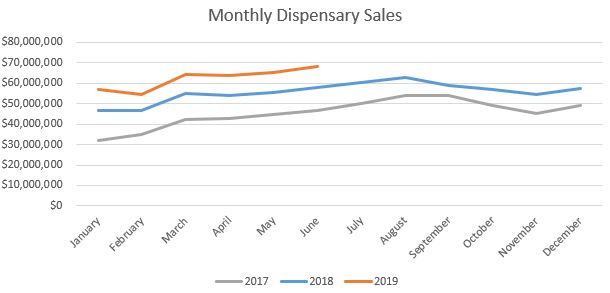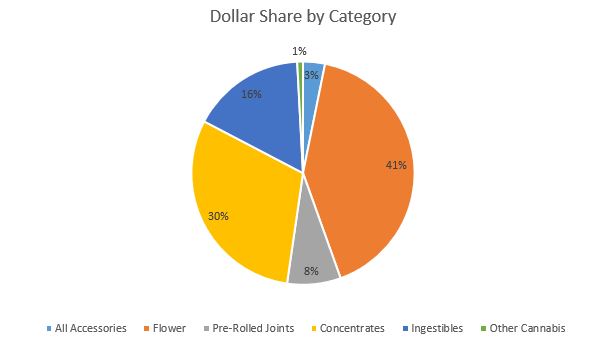We are pleased to share with our readers overviews on four important Western cannabis markets compiled by BDS Analytics for the month of June. BDS Analytics offers a full understanding of the evolving cannabis market though several offerings, including its GreenEdge Retail Sales Tracking, Consumer Insights, Industry Intelligence and CBD Market Monitor divisions. For those not familiar with the Colorado-based company, which was founded in 2015 and is run by co-founders CEO Roy Bingham and President Liz Stahura, we have been covering their progress since almost day 1.
During June, a common theme remained the decline in market share of flower sales relative to concentrates and ingestibles as well as the smaller category of pre-rolls. The overall share of the market for flower ranges from just 33% in California to 43% in Arizona. At the same time, the pre-roll category continues to show explosive growth, representing 4% of Arizona cannabis sales and 9% of California’s. Total sales growth varied across the market, with California showing year-over-year growth in June of just 1% as the state continues to struggle with licensing, Oregon growing 18%, Arizona expanding by 14% and Colorado increasing 8%.
Here is a more detailed look at each market, as detailed by BDS Analytics:
California
This past June, sales for California’s licensed dispensaries and delivery services reached a combined $248.9 million, decreasing two percent from May. Year-over-year sales for the month of June show an increased change of one percent and the combined year-to-date sales of $1.4 billion indicate 27 percent growth compared to the same period of time in 2018.
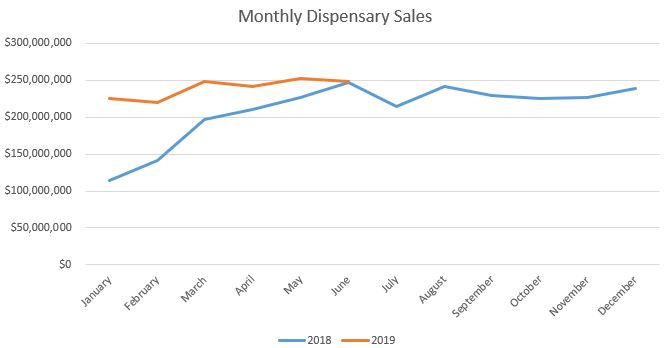 In June, Flower contributed 33 percent of overall revenues with $81.2 million in sales. Compared to May, sales in the category declined two percent while, compared to June, 2018, sales declined 14 percent. Year-to-date through June, sales of Flower reached $470.7 million, a seven percent increase compared to the same time period in 2018. This increase in revenue can be attributed to a 16 percent sales volume increase as a result of an eight percent decline in the average retail price of Flower. Flower prices in California remain significantly higher compared to other states but the data suggests that lower prices result in higher demand.
In June, Flower contributed 33 percent of overall revenues with $81.2 million in sales. Compared to May, sales in the category declined two percent while, compared to June, 2018, sales declined 14 percent. Year-to-date through June, sales of Flower reached $470.7 million, a seven percent increase compared to the same time period in 2018. This increase in revenue can be attributed to a 16 percent sales volume increase as a result of an eight percent decline in the average retail price of Flower. Flower prices in California remain significantly higher compared to other states but the data suggests that lower prices result in higher demand.
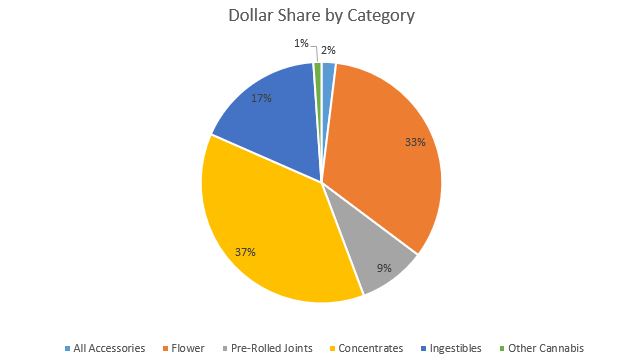
This past June, consumers in California spent $22.1 million on pre-rolled joints, a 14 percent increase compared to June, 2018. While sales of Flower have ceded share to other categories, pre-rolled joints are another matter. This past June, revenues from pre-rolled joints contributed nine percent of the overall revenue in California. In contrast with Flower, the pre-rolled joint category recorded a year-over-year average retail selling price increase of 27 percent while Flower prices only increased by one percent. With higher prices in pre-rolled joints, dispensaries experienced a decreased year-over-year unit sales volume of 10 percent.
Concentrates, a classification that includes extracts, solventless concentrates and vape products remained the largest category by sales revenue accounting for 37 percent share of overall revenue for the month. The $90.9 million in Concentrate sales remained constant from the trailing month and were 13 percent higher than June, 2018. In the first six months of 2019, Concentrate dollar sales increased by 45 percent and total units sold increased by 41 percent compared to the same time period in 2018. Vape sales dominate the Concentrates category every month, June of 2019 was no exception. Vape products made up 80 percent of the total units sold and 83 percent dollar sales within the Concentrates category.
Sales of Ingestibles reached $42.3 million this past June and contributed 17 percent towards overall revenues. Compared to June, 2018, sales in the category increased by 11 percent. Year-to-date through June, unit sales volume and average retail prices increased 26 and nine percent respectively, increasing total revenues by 37 percent compared to the same time period in 2018. The increased price of Ingestibles was primarily driven by an expansion of product offerings infused with CBD, which tend to cost more than THC-only alternatives. The Ingestibles category includes both Edibles as well as Sublingual products. As compared June of 2018, revenues from Edibles increased by 15 percent while Sublinguals decreased by two percent.
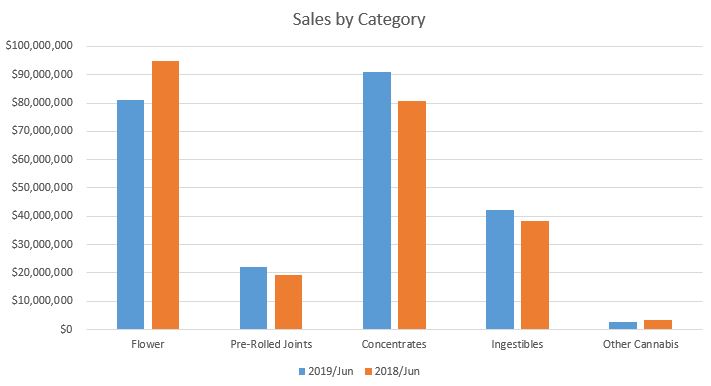 Oregon
Oregon
Sales for Oregon’s dispensaries were $68.3 million this past June, a five percent increase from May. Compared to June, 2019, sales increased by 18 percent. Year-to-date through June, sales have increased by 18 percent compared to the same period in 2018, reaching $373.3 million.
Flower sales reached $27.8 million in June, 2019, contributing 41 percent of overall sales revenue. Flower sales increased by five percent from the trailing month and increased by 16 percent compared to June, 2018. Year-to-date through June, Flower sales have increased 11 percent compared to 2018, reaching $149.9 million. Growth in the Flower category was driven by significant increases in sales volume, triggered by reduced prices. The average retail price for a gram of Flower in June, 2019, was 30 percent lower than June, 2018.
The $5.2 million generated from pre-rolled joints in June, 2019, contributed eight percent towards overall revenues for the month. Compared to June, 2018, sales increased 20 percent. Year-to-date through June sales in the category have grown 13 percent compared to the year prior.
Concentrates are a product category that contributed 30 percent of revenues in June. The $20.4 million in concentrate sales represented a 24 percent increase from the prior June. In the first six months of 2019, concentrate sales have increased 30 percent over the same period in 2018 to $114.2 million. Concentrate sales are segmented into dabbable and vape products. Compared to the prior June, sales increased 24 and 25 percent for the two subcategories, respectively.
Sales of ingestibles generated $11.1 million in sales in June and contributed 16 percent of revenues for the month. Year-over-year sales in June increased 15 percent. Year-to-date, the $31.6 million sold of ingestibles was 24 percent greater than the same period in the prior year. The ingestibles category can be segmented into edible and sublingual subcategories. Edibles contributed 76 percent of revenues within ingestibles in June. Year-to-date, sales of edibles have increased 21 percent and sales of sublinguals have increased 43 percent over the same period.
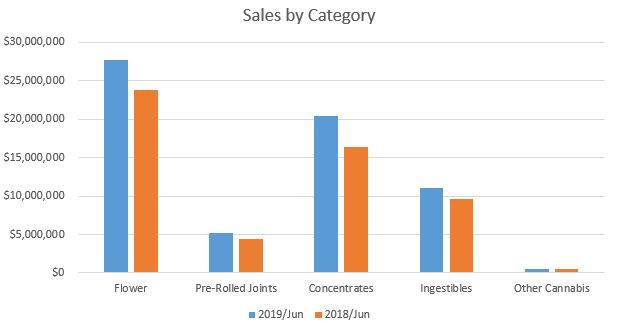 Arizona
Arizona
Sales for Arizona’s medical dispensaries were $56.6 million this past June, a four percent decrease from May, 2019. Compared to June, 2018, sales increased by 14 percent. Year-to-date sales increased by 13 percent compared the same period in 2018, reaching $333.6 million.
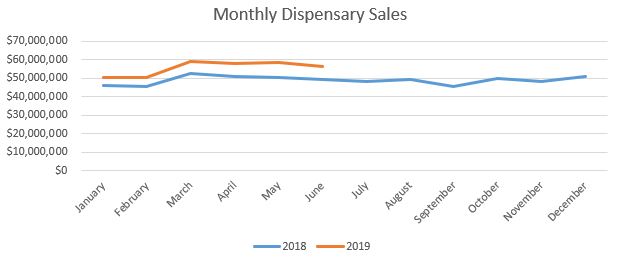
In June, the $24.1 million in sales of Flower contributed 43 percent of overall revenues for the month. Flower sales decreased by three percent from the trailing month and increased by 11 percent from the prior year. Year-to-date, Flower sales have increased four percent to $139.7 million.
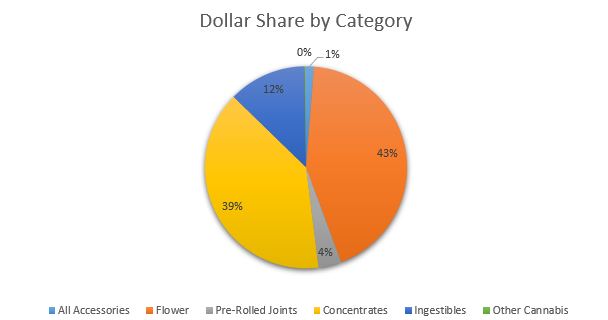
The Concentrates product category contributed 39 percent of revenues in June. The $22 million in Concentrate sales represented an 18 percent increase compared to the prior June. In the first six months of 2019, Concentrate sales have increased 21 percent compared to the same period last year to $128.4 million. Concentrate sales are segmented into Dabbable and Vape products. Compared to the prior June, sales increased 13 and 20 percent for the two categories, respectively.
Sales of Ingestibles generated $7 million in sales in June 2019 and contributed 12 percent of total revenues for the month. Year-over-year sales for June increased by 20 percent. Year-to-date, the $44.1 million sold in Ingestibles was 27 percent greater compared to the same period in the prior year. The Ingestibles category includes both the Edible and Sublingual subcategories. Edibles contributed 84 percent of Ingestibles revenues in June and sales increased 18 percent compared to June, 2018. Sales of Sublinguals in June, 2019 have increased 33 percent compared to the same period last year.
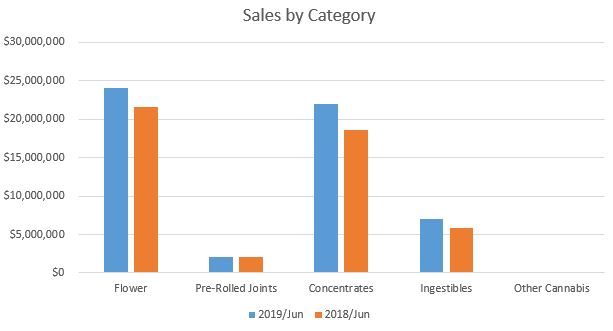 Colorado
Colorado
Sales from Colorado’s adult-use and medical dispensaries reached a combined $142.4 million this past June, a three percent increase from May. Compared to June, 2018, sales increased by eight percent. Year-to-date through June, sales in the Centennial state reached $810.9 million, an eight percent increase from the same period in 2018.

In June, Flower contributed 40 percent towards all revenues with $56.7 million in sales. The category experienced a 16 percent increase in volume of Flower sold compared to June 2018, but growth was offset by lower prices, resulting in Flower revenues remaining constant year-over-year. Year-to-date through June, sales of Flower have declined by two percent, reaching $326.7 million.
Pre-rolled joint sales generated $8.4 million this past June, a 12 percent increase compared to June, 2018. Year-to-date through June, sales of pre-rolled joints have increased six percent, reaching $46.2 million.
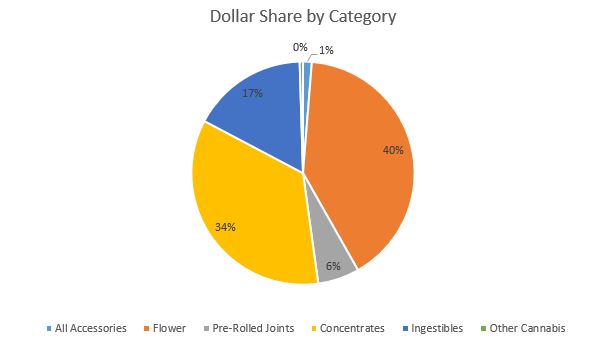
Concentrates are the second largest category by revenue. In June, sales of Concentrates contributed 34 percent towards overall revenues with $48.8 million in sales. Year-to-date through June, sales of Concentrates have grown by 18 percent. While concentrate sales in other state markets are dominated by the Vape segment, Colorado Vape sales make up only 54 percent of revenues in the broader Concentrate category. Year-to-date, Vape sales grew 43 percent compared to the same period in 2018. Dabbable Concentrates, which comprise the other 46 percent of Concentrate sales, only grew one percent within the same period.
Ingestibles remain firm in their position as the third largest product category. In June, sales of Ingestibles were $23.5 million, a 10 percent increase compared to June, 2018. The $133.6 million generated in year-to-date Ingestibles sales represent a 16 percent increase compared to the same time period in 2018. The Ingestibles includes the subcategories of Edibles and Sublinguals. Year-to-date sales revenues of from Edibles sales grew by 15 percent while the smaller Sublinguals segment grew by 36 percent compared to the same period in 2018.
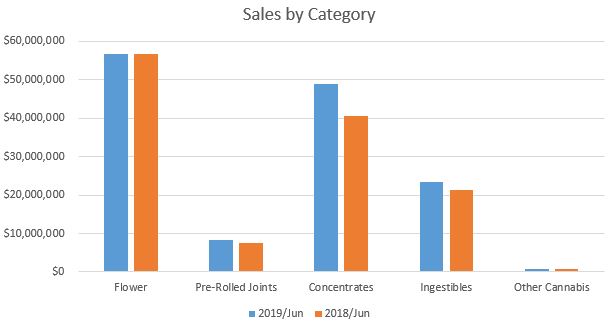
For readers looking for a deeper look at cannabis markets across these four states and more, including segmentation by additional product categories, brand and item detail, longer history, and segmentation by product attributes, learn how the BDS Analytics GreenEdge Platform can provide you with unlimited access to the most accurate and actionable data and analysis.

